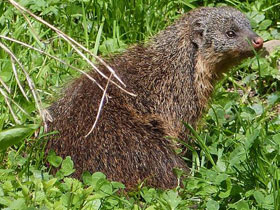The Gambian mongoose (Mungos gambianus)
The Gambian mongoose (Mungos gambianus) is a mongoose species native to the Guinean forest-savanna mosaic from Gambia to Nigeria. It is listed as Least Concern on the IUCN Red List since 2008.
Taxonomy
Herpestes gambianus was the scientific name proposed by William Ogilby in 1835 for a mongoose specimen from Gambia.
Appearance
Mungos gambianus is a species of carnivorous mammal that inhabits the humid savannahs of north-west Africa from The Gambia to Nigeria.
Mungos gambianus resembles striped mongooses, differing from them in the absence of bright stripes. Mungos gambianus has an elongated, slender body and a short snout. The tail is short, tapering towards the tip and covered with fine fur.
Mungos gambianus has 36 teeth, with only two molars in each jaw. The ears of Mungos gambianus are small, broad, strongly rounded; the eyes are small, rounded, dark. The limbs are short, hairless below the ankle, and the soles of the feet are bare. Mongooses of this species have long, stiff hair (short hair on the head). They have an anal gland which produces a characteristic aromatic secretion. Sexual dimorphism is not characteristic of Mungos gambianus. Adult length varies from 30 to 45 cm and tail length from 10 to 25 cm; weight varies from 1 to 2.2 kg. The coat of the Mungos gambianus is greyish in colour, with a narrow dark band running down both sides from the ear to the shoulder. Its throat and chest are yellowish. The tip of the tail and the legs below the ankle are black.
Habitat
The range of Mungos gambianus extends from southern Senegal eastwards to Nigeria. The eastern boundary of the range is indistinct. Mungos gambianus is found in Senegal, Gambia, Guinea-Bissau, Guinea, Sierra Leone, Liberia, Ivory Coast, Ghana, Nigeria, Benin, Mali (south), Burkina Faso (south), Togo. These animals stick mainly to humid savannahs and fields; occasionally they occur in semi-deserts and forests. In The Gambia, the species is usually found in coastal forests.
Nutrition
Mungos gambianus feed mainly on invertebrates; they eat a variety of beetles and millipedes. However, they also hunt rodents, reptiles and collect bird eggs. A group of mongooses forage for food in the early morning and late afternoon; in the heat, the animals rest in the den during the day. Mungos gambianus deftly glide between trees and stones, constantly sniffing and turning leaves. They can walk up to 3 km a day in search of food. Each individual forages independently, moving no more than 5-10 metres away from its relatives and constantly communicating with them by whistling. Skirmishes for prey are rare, and the first to find prey usually wins.
Way of life and peculiarities
Mungos gambianus are nocturnal terrestrial dwellers. They take refuge in hollow tree trunks, termite mounds or abandoned burrows of other animals, such as tubeworms or anteaters. A shelter is used for several days to two months. When in danger, mongooses secrete a foul-smelling secret to deter predators. Mungos gambianus also use this secretion, secreted by their anal glands, to mark their territory and others.
Social behaviour and reproduction
Mungos gambianus live in mixed groups of up to 40 individuals (usually groups of 6 to 20 animals). Noisy and violent clashes may occur between groups. During fights, mongooses fight one on one, with the winner chasing the loser, and then both return to the group. Older people defend their younger relatives. Mungos gambianus make chirping sounds while foraging to keep in contact with other members of the group. The high-pitched cries serve as an alarm signal. Mungos gambianus may also growl.
Mungos gambianus reaches sexual maturity at 9-10 months of age. Females and males often seek mates among members of other groups during intergroup encounters. Females may become pregnant again, 1-2 weeks after the birth of their young. Mungos gambianus breed up to 4 times a year. The births of the young usually occur during the rainy season. Pregnancy lasts about 60 days.
Interestingly, births of young are synchronised throughout the group (about 40% of females give birth on the same day). A litter may contain 2 to 6 calves weighing about 20 grams. All females care for their calves without dividing them between their own and other females' calves. The calves can suckle any female that has milk. While all members of the group forage for food, two males usually guard the cubs that have not yet emerged from the den. After a month, the young stop feeding on milk and join the group. Each young mongoose follows an adult mongoose, who trains it to feed, communicate, etc.
















































